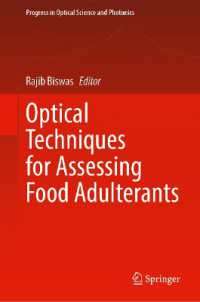Full Description
"Rate Adaptive Cardiac Pacing" provides a comprehensive
overview of this most advanced form of stimulating the heart
by means of cardiac pacemakers that vary the pacing rate
according to the needs of the patients. The heart rate is
controlled by one or several sensors that detect various
parameters such as respiration,blood temperature, oxygen
saturation, intracardiac pressure, QT interval, stroke
volume andbody activity. Besides describing the clinical
and functional characteristics of these various sensors, the
book also gives a clear understanding of hemodynamic aspects
and in particular, all clinical issues of importance such as
indications for rate adaptive pacing and selection of the
appropriate patients for rate adaptive pacemakers, with many
ECG samples. The book also covers new concepts in rate
adaptive pacing such as single lead atrial synchronous
pacing and the combination of various sensors, which are
among the most recent developments in the field. With
contributions from the most wellknown experts in the field
from allover the world, this book is the first publication
to cover all the hemodynamic, clinical and technical aspects
of rate adaptive cardiac pacing.
Contents
The Evolution of Bradycardia Pacing.- I. Basic Concepts.- Hemodynamics of the Paced Heart.- Chronotropic Incompetence and Natural History of Sick Sinus Syndrome.- The Impact of Exercise Metabolism; Catecholamine Levels and Individual Fitness.- General Characteristics of Sensors Used in Rate-Adaptive Pacing: The Ideal Sensor Open- and Closed-Loop Concept.- Indications for Implanting Rate-Adaptive Cardiac Pacemakers.- II. Clinical and Functional Characteristics of Sensors Used for Rate-Adaptive Pacing.- Activity-Sensing Rate-Adaptive Pacing.- Respiration.- Intracardiac Pressure for Rate-Adaptive Pacing.- Mixed-Venous Oxygen Saturation.- Central Venous Blood Temperature.- The QT Interval.- Closed-Loop Rate-Adaptive Pacemaker Based on the Ventricular Evoked Response.- Impedance-Derived Cardiac Signals: Preejection Interval, Stroke Volume and Ventricular Peak Ejection Rate for Rate-Adaptive Pacing and Antitachyarrhythmia Devices.- Stroke Volume: A Hemodynamic Variable for Rate-Adaptive Pacing.- III. Electrocardiography of Rate-Adaptive Pacemakers.- Electrocardiography of Rate-Adaptive Dual-Chamber (DDDR) Pacemakers: Lower Rate Behavior.- Electrocardiography of Rate-Adaptive Dual-Chamber (DDDR) Pacemakers: Upper Rate Behavior.- IV. Clinical and Practical Aspects of Rate-Adaptive Pacing.- Is Rate-Adaptive Ventricular Pacing Already Obsolete?.- AAI and AAI-R Pacing: Clinical and Technical Aspects.- Follow Up of Patients with Rate-Adaptive Pacemakers.- New Problems with Rate-Adaptive Pacing: Limitations, Adverse Effects, and Interference.- Technical Improvement to be Achieved by the Year 2000: Leads and Connector Technology.- V. New Concepts in Rate-Adaptive Pacing.- Single-Lead Atrial Synchronous Pacing.- Automatic Pacemakers.- Combinations of Parameters.- Future Trends.- Visionary Concepts on Implantable Devices.








